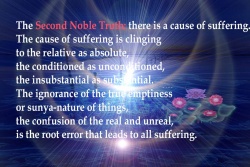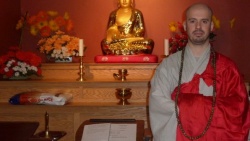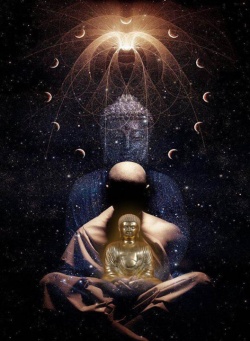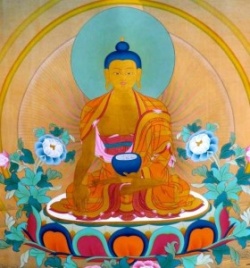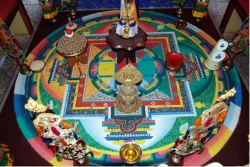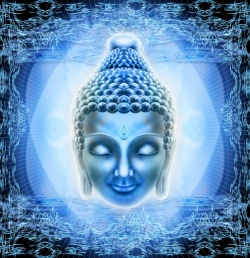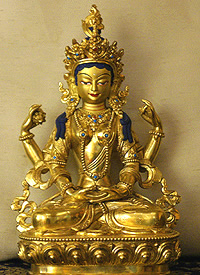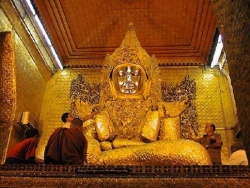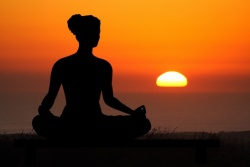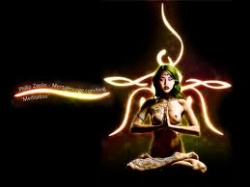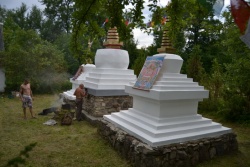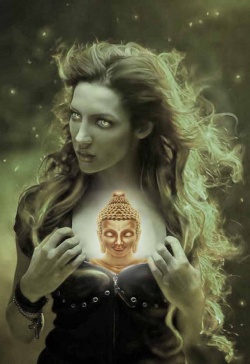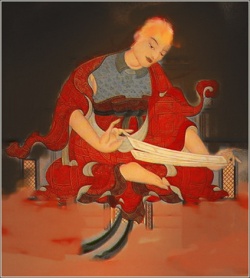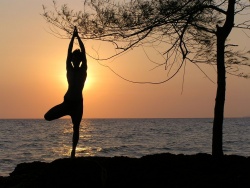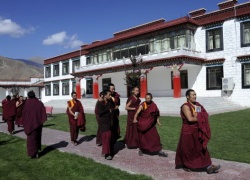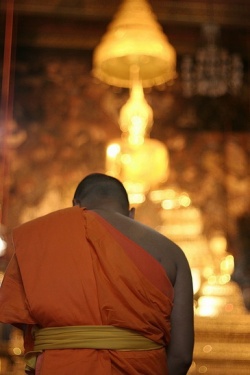Monasteries in Tibet
Jokhang Temple: The Jokang/Jokhang is Tibet’s most sacred temple, the main point of pilgrims from the entire Tibetan plateau.
Located at the heart of the ancient town of Lhasa, it was built in the 7 th century by the Tibetan King Songtsen Gampo’s queen Bhrikuti on a site identified by Queen Wencheng according to her geomantic calculation.
The temple is 3 stories high and it is constructed with enormous chapels including the most sacred statue of Budhha Shakyamuni, enshrined. It has around 70 monks.
Ramoche Temple was founded in the 7 th century by King Songtsen Gampo’s Chinese consort, princess Wencheng to house the image of Jowo Shakyamuni that is in Jokang temple in the present day.
Originally Ramoche temple was built in Chinese style but after being destroyed by fire, the present three storeyed building was constructed in Tibetan style.
In 15 th century, Ramoche was placed under the authority of Kunga Dondrup who is a second generation student of Tsongkapa.
Since then Ramoche has become the assembly hall of the Gyuto Tratsang, the Upper Tantric College of Lhasa and it had around 500 monks before.
The most revered image inside Ramoche temple is Jowo Mikyo Dorje ( Akshobhaya ), brought to Tibet in the 7 th century as part of the dowry of King Songtsen Gampo’s Nepali consort, Princess Bhirikuti Devi.
The image represents the Buddha Shakyamuni at the age of eight years. There are around 100 monks.
Drepung Monastery is the largest monastery in Tibet, built in the 15 th century by Jamyang Choeje who is one of Tsongkapa’s foremost disciple.
The monastery is beautifully located up in a hill at the distance of 7 Km from the old section of the city and it is the biggest monastery in Tibetan Buddhism. The monastery has four main colleges with numerous small chapels and house chapels, known as Khangtsen in Tibetan.
There are around six hundred monks.
Sera Monastery was founded in around 15th century by Jamchen Choeje who is another famous disciple of Tsongka pa and it is the second largest monastery of Tibet.
There are three big colleges with numerous chapels and house chapels.
The most attraction to visit this monastery is to see the monks debating which hold from 3-5Pm everyday apart from Sunday.
Ganden Monastery is situated 60Km east of Lhasa and it was founded in the 14 th century by Tsongka pa himself, named after the paradise of the future Budha Maitreya.
Ganden was the first and leading Geluk pa monastery, constructed by Tsongkapa himself.
The monastery has two main colleges known as Shartse (east point) and Jangtse (North point) were respectively founded by two of Tsongka pa’s closest disciples, Namka Pel Sangpo Neten Rongyelwa.
There is also a tantric college, established by another of Tsongka Pa’s students. Je Sherap Senge.
Samye Monastery located 210Km south of Lhasa and it is the first monastery of Tibet, built in 8 th century by the Tibetan King Trisong Detsen under the patronage of Padmasambhava and Shantarakshita.
Samye’s design was based on that of the Odantapuri temple of Bihar in India and is a mandalic symbol of the universe.
The central temple represents Mt Meru known as Sumeru in Sanskrit and the temples around it represent oceans, the continents and the sub-continents that surround the mountain in Buddhist cosmology. The monastery has around 170 monks nowadays.
Traduk Temple is the first temple of Tibet and according to the legend, it is one of the geomantic temples founded by King Songtsen Gampo in order to press down branches of the Supine Ogress body on which Tibet is believed to be situated.
The assembly of Traduk is surrounded by numerous small chapels like Jokang and the most revered object in Traduk temple is the ancient appliqué Thangka of Buddha Shakyamuni and the Avalokitesvara Thangka made of pearls.
Palchoe Monastery and Kumbum Stupa was founded in 14 th century by local Chieftain, Rebtan Kunsang for funeral of his mother’s death and it was once a complex of 15 monasteries that brought together three different Tibetan Buddhist sects in the one compound.
Nine of the monasteries were for Gelukpa Sect, Three were for Sakyapa Sect and the rest three were for Botonpa Sect which is one of the minor orders in Tibetan Buddhism.
At the present day, the monastery is composed of one main assembly hall and some small chapels, inhabited by 70 monks.
The Kubum Pagoda stupa was also built in 14th century by Rabten Kunsang.
The Stupa is nine storey high and 75 chapels, dedicated to the murals and statues, describing the tantric Tibetan Buddhism.
Shalu Monastery was originally built in the 11 th century by Jetsun Sherap Jungne of Shangshung and renovated with monastery extension in 15 th century by Gonpopel, Drakpa Gyeltsen and Buton Rinchendrup with the financial aids, provided by the Mongolian Emperor, Oljadu.
Shalu’s construction style is differed from those of other monasteries in Tibet that it has a Chinese style roof, made of yellow and green glazed turquoise tiles with porcelain relief carvings and it murals are painted in [[Niwari], Chinese and Tibetan styles.
The monastery is three storeys high and it has one assembly hall with some chapels on both ground and upper floors.
The main object of the monastery is the black stone statue of Chenresig Kasrapani. Shalu has 65 monks.
Tashi Lhunpo Monastery is the seat of the Penchen Lama, built in 15th century by the first Dalai Lama,called Gedun Drub. On the slops of Drolmari, situated to the west of the fortress of Shigatse Dzong.
The monastery is composed of 3 big colleges such as Tsennyi college, Ngapa college,Tse Gonkang college and one big assembly hall with numerous chapels around.
The main object of the monastery are the giant gilled copper statue of the Future Buddha Maitreya which is (26Meters) high, built in 1914, embodying loving kindness, contains 6,700 teals of gold and 150 metric tons of copper, and within it, an enormous juniper tree from Reting monastery functions as a life-supporting axis, Sok-Shing in Tibetan,
The tomb stupas of the successive Panchen Lamas, the tomb of the 4 th, 10 th and from those of 5 th to the 9 th together respectively. There are around 500 monks.
Sakya Monastery was built in 12 th century by Khon Konchok Gyelpo from Sakya clan.
The monastery was originally built for the schools of Sakya tribe and later on it was expended to the present size by Dogon Chogyel Pakpa.
Drogon Chogyel Phakpa is the first Tibetan Lama who took the ruling power in Tibet.
Sakya is the mother monastery of Sakyapa sect.
The temples of North Sakya were built first and within these temples, the Gorum temple to the northeast was the oldest, built in 1073 by Khon Konchok Gyelpo.
The Utse Nyingpa, Utse Sarpa)], Manjughosa temples were constructed by Sachen Kunga Nyingpo, [[Choje Drakpa Gyeltsen and Sakya Pandita Kunga Gyeltsen around the meditation cave of Sachen but most of those temples are invisible now.
The temples of South Sakya, composed of one main assembly hall, college buildings, palaces and some chapels were gradually built during the time of Drogon Chogyel Phakpa.
The Sakya monastery has 160 monks.
Tsurpu Monastery is the seat of the Karmapa and it was founded in the 1180s by the first Karmapa Dusum Kyenpa, some forty years after he established the Karmapa order in Kham, the place where he was born and Tsurphu was the third Karmapa monastery to be built and after the death of the first Karmapa, it became the head monastery for the Sakyapa order.
The monastery is composed of one main assembly hall and some chapels.
The main object of the monastery is some very revered relics of the 16 th Karmapa, as well as statues of Amitabha and Shakyamuni.
Tsurphu has 300 monks nowadays.
Reting Monastery was constructed in the 11 th century by Dromtonpa, the foremost Tibetan student of the great Bangali master Atisha.
Here Dromtonpa established the principle seat of his Kadampa school and according to legend, 20,000 Juniper trees and Springs emerged from the hairs of his head miraculously.
The monastery was expended by Dromtonpa’s successors and the great 5th Dalai Lama.
During the 7 th Dalai Lama, Reting monastery became the seat of the Reting Rinpoche successives when the 4 th Reting Rinpoche Ngawang Chokden became the teacher of the 7 th Dalai Lama.
The main object in the monastery are the statue of Jowo Jampel Dorje and a very sacred cave used by Tsongkapa when he wrote Lamrim Chenmo, the stages of the path to enlightenment. There are around 70 monks.
Drigung Thil Monastery is the head monastery of the Drigungpa school of the Kagyupa order.
The Drigungpa is one of the eight schools derived from the teachings of [Phakmodrupa Dorje Gyelpo]] whose seat was established at Densathil, northeast of Tsetang.
In 1167, a hermitage was founded at Drigungtil by Minyak Gomring, a disciple of Phakmodrupa and it was expended by Phakmodrupa’s most famous student, Jigten Gonpo.
The main object in the monastery are the statue of Jigten Sumgon, the founder of the monastery,Guru Rinpoche and Shakyamuni respectively. There are 270 monks.
Tridom Hermitage or Nunnery was built when the King Trisong Detsen offered his queen to Padmasambhava. The Padmasambhava concealed lots of treasures in the Kiri Yangdzong cave above Tridom.
Yeshe Tosgyel herself also remained in meditation in Tridom for many years, which is why the original nunnery was constructed at this particular point.
There is medicinal hot springs within the nunnery which can be considered to be the cleanest natural hot spring in Tibet and it is full of visitors during the whole year.
There are around 130 nuns at present in the nunnery.
Mindrol Ling Monastery was built in the 17 th century by Orgyen Terdak Lingpa and it is believed to be the biggest Nyingmapa monastery in the Utsang region.
The monastery has one main assembly hall and it is dedicated to the statues of Guru Rinpoche and Terdak Lingpa.
The main assembly hall itself has another statue of Terdak Lingpa, along with Dorje Chang ( Vajradhara ) and a row of Kadam-style Chortens.
The monastery has around 70 monks at the present day.
Phuntsok Ling Monastery and Jonang
Kubum was once the central monastery of the Jonang Pas (Jonang Kagyu subsect).
This Jonang Kagyu subsect is especially known for the examination of the nature of emptiness which is practised in the monastery by its greatest scholar, Dolpopa Sherap Gyaltsen (1292-1361).
The Jonang Kubum was built by Dolpopa Sherap Gyaltsen in the 14 th century and it was the spiritual centre of Jonang Pas.
The murals on the wall in Jonang were painted by Tibetan artists in the 14 th and 15 th centuries and they were bly influenced by the Nepalese styles.
It was said to be one of the best preserved monuments in Tibet, resembling the Gyangtse Kubum.
Drathang Monastery an important conservation site for Tibet’s artistic heritage.
The temple complex like Samye monastery was founded in 1081 by Drapa Ngonshe, a native Dranang valley and one of the 13 saints associated with it and completed in 1090 by his nephews.
The ground floor of the monastery preserves a marvelous wall painting both in Newari and Tibetan style and it is the best fascinating wall paintings preserved in the central part of Tibet.
Tholing Monastery the temples and religious buildings of Tholing are the most significant in far west Tibet.
The monastery was constructed under the guidance of the great Tibetan translator Rinchen Zangpo in around 11 th century although some historian refers to the date of 996.During his life time, he is said to have built 108 temples throughout far west Tibet and Ladhak eventhough few still exist, those at Tholing are considered to be the best examples of Guge style of Buddhist art.
Tholing was the main religious centre prior to the visit of the great Indian Pandit Atisha due to the influence of Rinchen Zangpo.
Atisha was invited by Rinchen Zangpo under the instruction of the Guge King Yeshe-O.
As the history goes by, Yeshe-O was very devoted to Rinchen Zangpo’s activities and he himself founded the monasteries in Tholing.
Yeshe-O sent his men to India to invite Atisha several times but they returned after being refused their request several times.
Yeshe-O sacrificed all his life in order to invite Atisha.
He was captured by invading troops from Qarloq who demanded ransom.
When Yeshe-O’s nephew Jangchub O tried to save his life, Yeshe-O responded to his nephew by saying ” I am an old man. My life now is short.
Use the ransom to invite and assist Atisha to come to Tibet.
When Atisha was moved by Yeshe-O’s dedication to Buddhism, Atisha finally agreed to visit Tibet and he was amazed to see Buddhism flourishing when he arrived in Guge.
[[Kalden Jampling] Monastery was founded in the 15 th century by one of the Tsongkapa’s disciples, Jangsam Sherap Zangpo.
It is the largest Gelukpa establishment in the Kham region and the development of the monastery was maintained over the centuries by the successive incarnations of Pakpa Lha whose father Kuchor Toden, had been an actual disciple of Tsongkapa.
The most revered object in the monastery are the statue of Maitreya or the future Buddha, Tsongkapa and his two main disciples, Kedrup Je and Gyeltsep Je and the statues of 16 arhats respectively.
Palpun Thubten Choeorling Monastery was founded in 1717 by the 8 th reincarnated Tai Situ Chokyi Jungne and considered to be the biggest establishment of Kagyupa sect in Derge and it rapidly became the most important study centre in east Tibet for the Kagyupa tradition.
Before the construction of the monastery, the 7 th reincarnation of Tai Situ lived mostly at Karma Gon monastery in lhato.
The main object in the monastery are a large gilded copper image of Maitreya, flanked by Padmasambhava and Tara.
Kardze Monastery was originally constructed by Mongolian Qosot which has around 540 years history and it was the second largest monastery in Kham region.
The monastery has assembly hall and some small temples like other monastery and Inside the main assembly hall, there are statues, representing the founders of the Kadampa, Gelukpa, and Nyingmapa lineages of Tibetan Buddhism.
There are around 7 hundred monks nowadays.
Kumbum Jampaling Monastery was founded in 1560 by Rinchen Tsondru Gyaltsen to commemorate the birth place of Tsongkapa, the founder of the Gelukpa sect which is the most well-known sect of Tibetan Buddhism.
The monastery is built around the tree that marks Tsongkapa’s actual birth place where Tsongkapa’s mother had herself built a stupa ( Kumbum ) meaning thousand images in 1379.
Later in 1583, the 3 rd Dalai Lama Sonam Gyatso stayed here and encouraged Rinchen Tsondru Gyaltsen to build a Maitreya temple, Jampa Lhakang in Tibetan. After the site became known as Kumbum Jampaling.
The most sacred temples are the Serdong Chenmo was originally built by Tsongkapa’s mother in 1379 on the spot where a sandalwood tree is said to have appeared miraculously from the ground where Tsongkapa’s placenta fell at the time of his birth.
Jamkang, the temple dedicated to the Maitreya statue, representing at the age of 12 and the reliquary stupa of Rinchen Tsondru Gyaltsen which dates from 1583.
Labrang Tashikyil Monastery is one of the six biggest Gelukpa monasteries in Tibet and it is the largest Gelukpa monastery in Amdo region.
It was founded in 1709 by the first Jamyang Zhepa Ngawang Tsondru who was revered as an emanation of Tsongkapa’s teacher Umapa Pawo Dorje.
During his studies in Lhasa, where he was a contemporary of Desi Sangye Gyatso, he received his title “Jamyang Shepa. After returning to his homeland, he then founded the most powerful monastery in Amdo.
The main buildings of the great temples and colleges of Labrang Tashi Kyil were constructed by Jamyang Shepa and his successors.
He himself founded the Tsokchen Dukhang Tosamling or assembly hall in 1709, the Gyume Dratsang or lower tantric college in 1716, the Sokshing Chora or college of dialectics and the Jokang temple,
containing a much revered Jowo Rinpoche image flanked by 108 others in 1718 and the rest of the temples or the colleges were built by the successors of Jamyang Shepa respectively.
